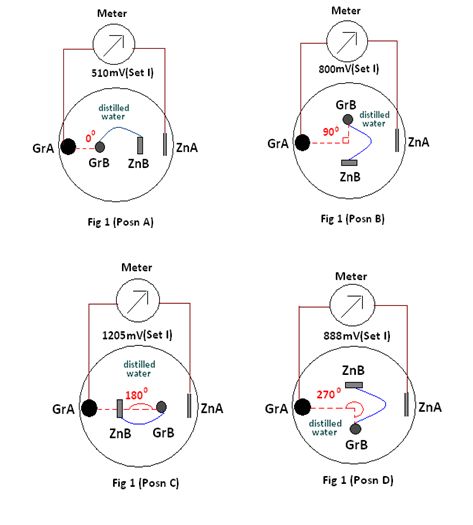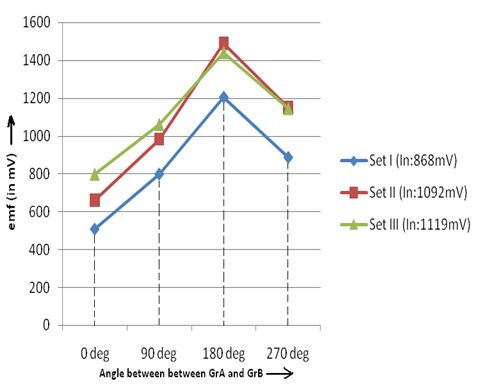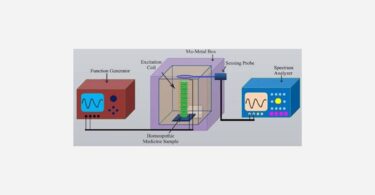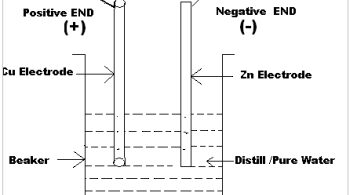Homeopathic dilutions are often discounted by critics due to the absence of any molecules of the original substance. Even though no molecules are present, the remedies still work. The carrier of the remedy being water for either liquid or solid medicine, the properties of water need special attention. It has been stated in our earlier papers that the electrical energy of a substance is conveyed through water by rearrangement of orientations of dipoles of water molecules (just like magnetic properties of a magnet 1.) The electrical properties of water are directly related to how homeopathy works2. This property of water which allows rearrangement of orientation of dipoles according to its environment, helps explain many of the mysteries associated with homeopathy. 2,3. Here we present another experiment to shed light on these mysteries.
Experiment: Two sets of electrodes GrA-ZnA & GrB-ZnB are taken and immersed in distilled water in a beaker . Emf for each pair are measured and recorded in the table below4,5 (table 1) . Now GrB-ZnB are connected externally through a wire ( shown in blue color) .The connected GrB-ZnB pair is now placed at different positions as shown in fig 1 .The final emf of GrA-ZnA pair is measured and noted for the condition
i) when GrB is placed at 00 with reference to GrA (Fig 1 Posn A)
ii) when GrB is placed at 900 with reference to GrA (Fig 1 Posn B)
iii) when GrB is placed at 1800 with reference to GrA (Fig 1 Posn C) &
iv) when GrB is placed at 2700 with reference to GrA (Fig 1 Posn D)
Result:
Table:1
| Set No. | emf of GrB-ZnB (in mV) | Inintial emf of GrA-ZnA (in mV) | Final emf of GrA-ZnA for different positions(in mV) | |||
| Position A (00) | Position B (900) | Position C (1800) | Position D(2700) | |||
| Set I | 1150 | 868 | 510 | 800 | 1205 | 888 |
| Set II | 1120 | 1092 | 660 | 983 | 1490 | 1152 |
| SetIII | 1096 | 1119 | 800 | 1062 | 1440 | 1145 |
Observations &Discussion:
Here it is found that the emf of GrA-ZnA pair (position unchanged) changes on immersing the connected pair in the water. It is different for the different positions of the connected pair. When the angle between GrA &GrB is 00 the emf is 510mV (set I), well below the initial emf of 868 mV. For the angles 900 ,1800 & 2700 it is found to be 800mV 1205 mV & 888 mV respectively (all for set I). It shows that the connected pair influences the emf of GrA-ZnA pair according to its position in water. But as the electrodes of the connected pair (GrB-ZnB ) have no reaction with water, then how does it influence the emf of GrA-ZnA pair ? Moreover, why the emf of GrA-ZnA pair vary with reference to the position of the connected pair is also not known. Considerable increase in emf of the GrA-ZnA pair as for position C, may be attributed to the series connection as we found in combination of cells. Then the question arises:
i) Why is the emf of the GrA-ZnA pair for position C 1205mV which is quite lower than 1962mV the sum of emf ofGrA-ZnB(930mV) & GrB- ZnA(1032mV) for series connections?
ii) Why is the emf of the GrA-ZnA pair 510mV for position A, even lower than the initial emf of 868mV.
iii) Why is the emf of the GrA-ZnA pair 888mV for position D that is again slightly higher than the initial emf.
Now a graph is plotted for all the three sets with the angle (in 0) between the GrA & GrB on the X axis while the resultant emf of GrA-ZnA pair is on the Y axis.
From the graph it is clear that with the increase in angle of the connected pair (GrB-ZnB) with reference to Gr A there is a steady rise in the resultant emf for GrA-ZnA pair till 1800 after which there is a steady fall of the resultant emf.
The results however, reflect that the resultant emf of the stated pair (GrA-ZnA) is not due to any series connection for immersion of the connected pair (GrB-ZnB) at different positions. Such generation of variable emf of the GrA-ZnA pair cannot even be explained due to the presence of ions of water (H3O+ & OH–) as it is not possible for inert pair of electrodes(GrB-ZnB) to influence the ionization of water. The above result can only be explained considering the fact that any substance introduced in water brings about rearrangement of orientations of water molecules 1. Here the orientation imparted by the GrA-ZnA pair is altered on immersion of the connected pair, due to the combined effect of orientation imparted by the GrB-ZnBpair for each position. As for each position of GrB-ZnBpair, the resultant orientation is altered, hence the emf generated by the GrA-ZnA pair differs.
Inference: The results obtained are not simply due to a series of connections of cells and cannot be explained by the ionization theory or electrolysis, but can only be explained on the basis of rearrangement of dipoles of water molecules, the driving force for homeopathy.
Reference:
[1]. The Homeopathic Dilution-A New Explanation, Ruhul Amin, Biplab Chakraborty & Farook Rahaman (Simillimum,vol.XXI,Summer Fall/2008. www.hanp.net )
[2] The electrical energy of substances –the secret of homeopathy, Ruhul Amin & Biplab Chakraborty (Simillimum,vol.XXII, Summer Fall/ 2009www.hanp.net)
[3]. Orientations of water molecules-the force behind Homeopathy, Ruhul Amin ,Biplab Chakraborty (Published in Homeopathy For Everyone Apr 2013 hpathy.com)
[4]. Water the magic liquid retaining electrical energy. Ruhul Amin & Biplab Chakraborty(Published in Homeopathy For Everyone Apr2012 hpathy.com )
[5]. Generation of electrode Potential of an electrode –an explanation, Ruhul Amin & Biplab Chakraborty (Simillimum,vol.XXIII.2010, www.hanp.net)






Thought you might find this interesting
http://www.techhive.com/article/216767/dna_molecules_can_teleport_nobel_winner_says.html
Sir
Got it. Thanks.
Ruhul & Biplab
Hi, I have a question: once transported, homeopathic remedies are exposed to various EMF from environmental sources and or from radiations at airport control scanners etc..
It is difficult to imagine that the information stored in the water memory of these molecules is not adversely affected by it. I would like to find scientific argumentation to demonstrate it, and ultimately to propose a compound of materials that could prevent such deterioration. My question is more: how can we scientifically explain this deterioration ? Thank you for your feedback